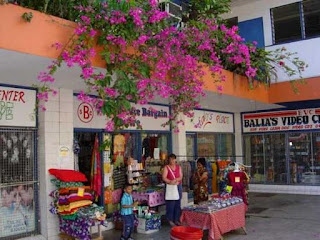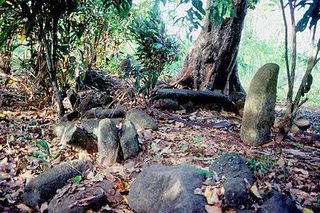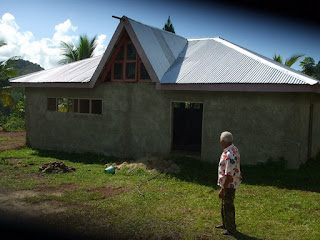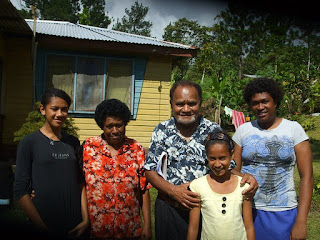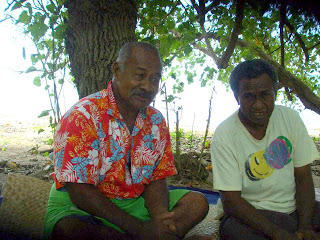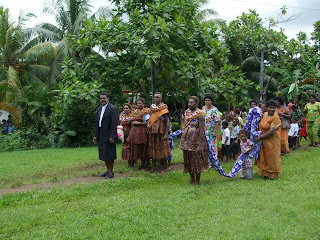
from w
I thought the writer was going to talk about lizards of the many-legged variety, but then she goes on to talk about society. Good on you girl!
From the Fiji Times Features:
Dance like the matadors
Fay Volatabu
Monday, December 19, 2011
Picture: Asinate Bakabaka with a crested iguana at Kula Eco Park in Sigatoka. Picture: BALJEET SINGH/ THE FIJI TIMES FILE
RECENTLY, a German national was prosecuted for trying to smuggle a crested iguana out of our country. I wondered why would anyone want to pack such a creature in their bag and literally share the ride with it. As you would have guessed, I have a special negative relationship with the reptile specie and though the size may not matter, a reptile is a reptile whether it be minute, pretty, or priceless, I would literally run a mile when I see one.
Despite my fear and utter dislike of reptiles, a particular type has been my nemesis for life. Wherever I turn I see one, the chameleon to be exact. I have been living with them all my life and often it is quite difficult to distinguish the animal from the surrounds.
The chameleon is a small lizard that changes colour according to its surroundings. Have you seen any in your neighbourhood lately?
They are the ones that go to church on Sunday, speak about eliminating violence but beat up their wives every other day, go to work in a reputable office dressed in a suit, talk about transparency but are secretly involved in corruption; speak words of edification and honour but secretly defame characters; appear to be a saint, go to all the church meetings and are great givers but secretly venomous pythons? I'll ask again, have you seen any lately?
These chameleons change colours depending on the surroundings and often you cannot even tell them apart.
These reptiles have the tendency to change colour, change character and are very unreliable as they change with the wind, the backdrop or circumstance. Today, the backdrop would be green and they would be also, but tomorrow when it is orange, you will not see them as they will also be orange. They will say anything or in some cases, do anything to be invisible and we must commend them for their versatility as they would be good spies for any secret service.
But, in the real world where real people with real problems and real challenges exist, they are sometimes the deadliest people around as they will save their own skins or shed their skins to be alive.
It is now getting to the end of the year and as business winds up, it is also a time to reflect on the year. Have all the commitments we made been carried out? Did we stop victimising our wives or children and family members? Did we improve our fiscal policies?
Did we honour the commitments made in secret or did we just say words in haste to suit the situation but reneged on our agreements or on our word because we did not feel like it, or because the circumstances changed and with it our responses, like the chameleon.
Our nation has evolved in that unlike before when things were solved by the war club or bare knuckles. We have refined our skills and become more dialogue-prone.
What this means is that unlike before when all a warrior had to do was to reaffirm his power with a wield of his club to show people how he felt, now it is through 'dialogues', 'conferences', 'conventions', and we cook up so many eloquent expressions and academic endeavours such as chat cafes, chat rooms, roundtable, square table and whatever else to describe our attempt at finding solutions to some mundane and trivial issue which could easily be solved through action. Wouldn't it be better just to say meeting or discussions and call a spade a spade?
Need we become chameleons and join the crowd crying out for dialogues, panels, conferences, conventions in the bid to be relevant, yet, risk being more irrelevant in the process?
We have conventions, we have laws such as the Universal Declarations of Human Rights, Convention on the Elimination of Discrimination Against Women, Convention on the Rights of the Child, the Domestic Violence Decree, Family Law and many other international and local legal instruments.
Why do we need to keep on discussing or dialoguing the obvious when we need to go the next step up, which is, action.
Is it necessary to have cafe discussions, virtual chats , roundtables, conventions, conferences or spend more time and money or whatever new form of pow wow is yet to be cooked up?
Shouldn't we just cut to the chase and just start acting on previous discussions and recommendations?.
If you asked me, dialogue is just a fancy way of saying detour, or roundabout or maybe red lights ahead. We have legal instruments, we have our commitments, we have our honour and integrity to live for and live by.
Must we keep on dialoguing and say what needs to be said in a given situation and keep on changing our tune and risk being like the chameleon who will change colour to suit the backdrop?
Or can we be like the German national who saw the value in a crested iguana (even though I cannot comprehend such fascination neither do I condone his method) and decided to act on his impulse and gut feeling regardless of the consequences.
Don't get me wrong, I am not condoning the illegal act but the spirit which prompted the act and that was urgency and action in seeing something of value.
Maybe it is like that with the matadors of Spain, where they dance with the bulls and try and coax them into a corner.
The matador dances with the bulls but at the end of the day, he gets the results. Can we start dancing like the matadors and take the bull by the horn, move a step up from the dialogues and start the actions now?
Can we not tolerate violence in all our homes anymore?
Can we stop beating and neglecting our children?
Can we have shelters for our rural women selling at the markets? Can we have more businesses for women supported and set up?
Can we ensure that women are taken into consideration whenever a policy, a development or even a prayer is said?
If we can truly do that instead of just saying it, then we have truly evolved from being a versatile and scared chameleon to being a priceless crested iguana that the world would die for, or in some case go to jail for.
So what are you? Chameleon or crested iguana? If you are a true native of Fiji, then remember that you are a critically endangered specie and more importantly, we need you to chase out all the chameleons. God Bless Fiji and all its habitats, great or small.
* Fay Volatabu is the general secretary for the National Council of Women Fiji. Email: secretary@ncwfiji.org or ncwfgs1@gmail.com.

